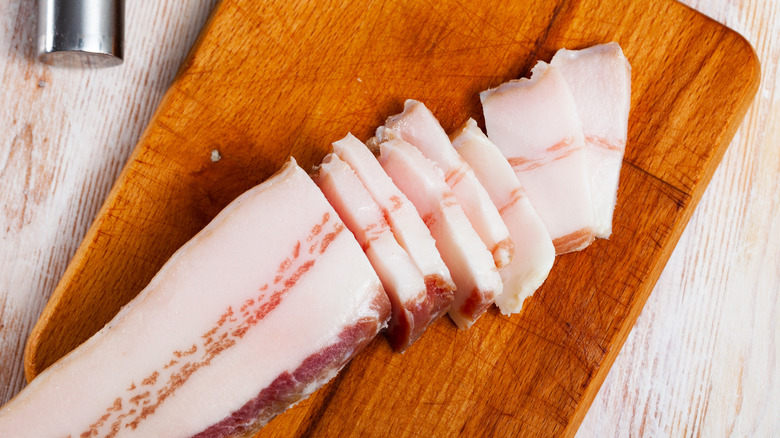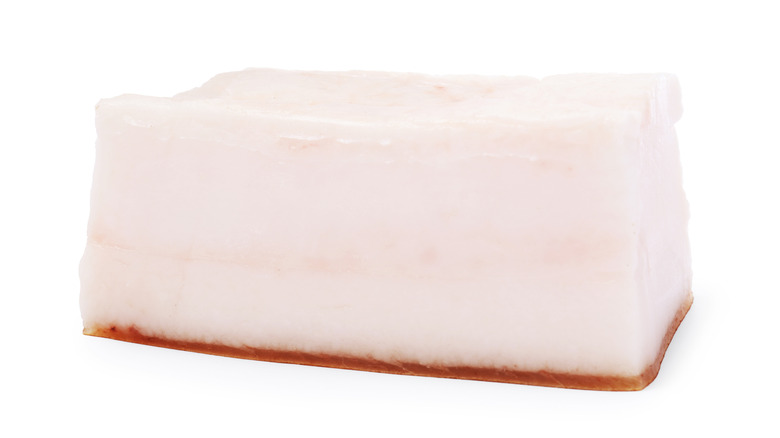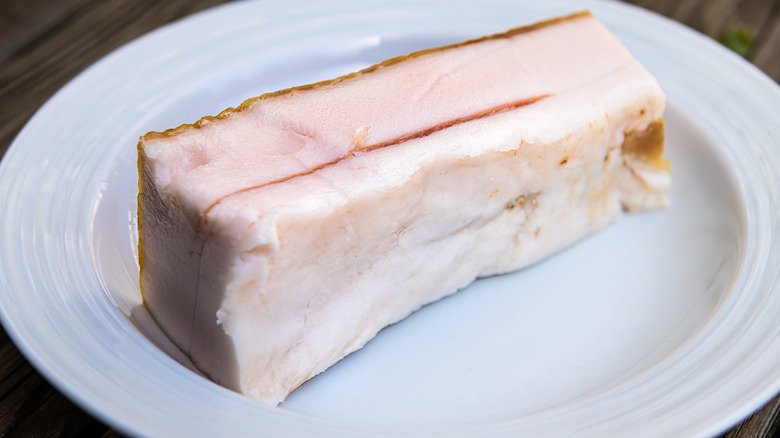Salt Pork Vs Fatback: What's The Difference?
If you've ever thumbed through a collection of Southern recipes, you probably noticed that a lot of them call for salt pork or fatback. Despite the fact that both cuts are simply fatty pieces of pork, it's important to know that the two are not entirely interchangeable before you head to the butcher shop or counter. The difference comes down to how the meat is treated before it's sold. Fatback is, essentially, pure fat taken right from the pig and sold as-is. Salt pork, on the other hand, is fat that's been heavily salt cured and sometimes has a bit of meat streaked in.
Each porky ingredient is really only useful for certain types of recipes and preparations. For instance, classics like chowder and slow-cooked collard greens are almost incomplete without a chunk of salt pork. Fatback, on the other hand, is integral for making all types of charcuterie, or it can be sliced thin and added to dishes to add richness and flavor. Let's take a look at these two types of pork fat a little more in depth.
What is fatback?
Fatback gets its name from the area of the pig where it's cut — the back. Pigs have a lot of fat in general, but this particular portion forms fibrous slabs that occur naturally on either side of the animals' back bone and next to our favorite secret cut, the pork skirt steak. It might not be the most imaginative name for an ingredient, but it's the easiest way to remember where it comes from (and thus one of the ways it's different from salt pork).
Although fatback is almost all fat, it's not loose, spreadable fat like lard, which is made by rendering fat from pork meat. That texture makes fatback the ideal ingredient for creating sausage, patê, and other types of charcuterie, because it adds flavor and moisture that won't melt away when the food is cooked. In fact, any time you see white gobs of fat in salami, bologna, or patê, that's fatback.
Many chefs also use fatback with ingredients like turkey or vegetables that are naturally low in fat to add moisture and flavor. You can either wrap something with thin slices of fatback and cook it, which is called barding, or insert it into something like a turkey breast, which is called larding. It's also delicious as a base fat for cooking vegetables like cabbage, potatoes, and turnips.
What is salt pork?
The most obvious difference between fatback and salt pork is the taste, which comes down to the curing process. Depending on the producer, salt pork is either wet or dry brined with lots of salt in order to draw the moisture out of the fat. This process gives the meat a long shelf life, as foodborne bacteria can't grow without moisture, but it also gives it a deep, salty flavor that's similar to Italian pancetta. Fatback, on the other hand, has a mild, fresh pork flavor.
Curing isn't the only difference between fatback and salt pork, either. Salt pork actually has more in common with bacon than it does with fatback since it's usually belly meat, and that's where bacon comes from. The only major difference between bacon and salt pork is that bacon is smoked after it's cured, while salt pork is not smoked. Salt pork is sometimes made from fatback, but not nearly as often as the belly.
Salt pork is a secret weapon ingredient in soups and stews, which allows the rich, salty flavor to really permeate a dish while the fat is rendered. Perhaps its most famous role is the star of baked beans, and even if you've never cooked with salt pork you've probably noticed a chunk of white stuff floating in cans of beans. And if your store-bought beans don't have any, adding a chunk of salt pork is an easy upgrade to make them taste like homemade.


